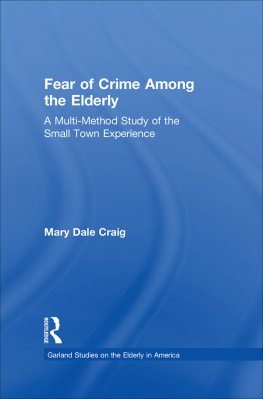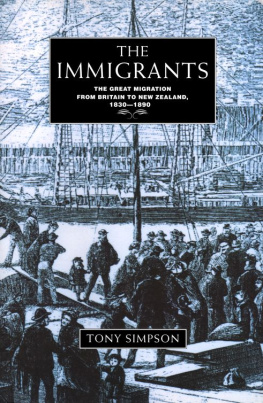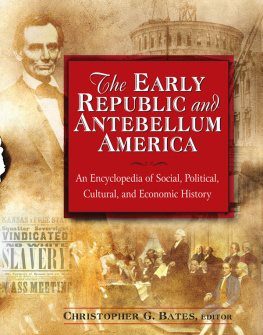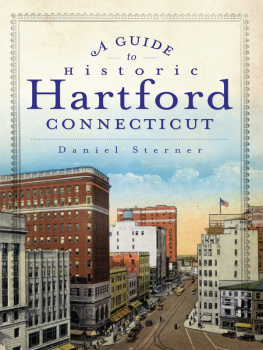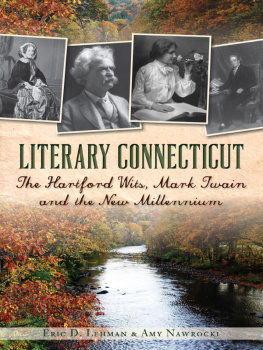First published 1997 by Garland Publishing, Inc.
Published 2019 by Routledge
2 Park Square, Milton Park, Abingdon, Oxon OX14 4RN
52 Vanderbilt Avenue, New York, NY 10017
Routledge is an imprint of the Taylor & Francis Group, an informa business
Copyright 1997 Paula A. Scott.
All rights reserved. No part of this book may be reprinted or reproduced or utilised in any form or by any electronic, mechanical, or other means, now known or hereafter invented, including photocopying and recording, or in any information storage or retrieval system, without permission in writing from the publishers.
Notice:
Product or corporate names may be trademarks or registered trademarks, and are used only for identification and explanation without intent to infringe.
Library of Congress Cataloging-in-Publication Data
Scott, Paula A., 1963
Growing old in the early republic: spiritual, social, and economic issues, 17901830 / Paula A. Scott.
p. cm. (Garland studies on the elderly in America)
Includes bibliographical references and index.
ISBN 0-8153-2537-1 (alk. paper)
1. AgedUnited StatesHistory. 2. AgingSocial aspects United StatesHistory. 3. AgingEconomic aspectsUnited StatesHistory. 4. United StatesSocial conditionsTo 1865.
I. Title. II. Series.
HQ1064.U5S396 1997
305.2609746dc21
96-48389
ISBN 13:978-0-8153-2537-6 (hbk)
The sun riseth upon us, and giveth us the
cheerful morning of youth; but how soon is it
that he setteth, and we are surrounded
with the shades of the evening of old age.
When these words were first articulated in 1829 everyone who heard them could bring to mind a picture of the aged in early national America. Men and women living in the years between 1790 and 1830 understood the special experiences and challenges that marked old age. Unfortunately, much of what Americans knew about old age in this period was lost as historians in the succeeding decades overlooked the aged's stories. Only recently have scholars begun working in earnest to reconstruct an understanding of old age in past times.
This book provides one building block for this new understanding. It looks at a specific time and placeConnecticut in the years between 1790 and 1830to illuminate the spiritual and emotional aspects of being elderly, the economic consequences of growing old, and the ways social experience changed with advancing years. In doing so it demonstrates that life for the aged was risky and uncertain due to challenges on several fronts. Indeed, the research presented here reveals that early national Americans were quite accurate in referring to old age as the "declining years" and why old age was, as in the verse above, likened to somber shades of darkness. But challenges and risks were not the only important hallmarks of old age in this period. Indeed the way in which men and women approached old age is also significant. In the absence of institutional structures and pathways to guide the aging process, Americans in this "preindustrial" era negotiated old age on a highly individualized basis. Though we often think of the United States in this era as communally and family based, evidence on the elderly's lives shows that to a large extent constructing old age was an individual responsibility.
This book is not the first work on old age in America's past. In recent years scholars have focused more and more attention on the elderly and made many important findings. Interest in the aged has been spurred by the development of research methods that allow historians to better capture the experience of previously ignored groups. In addition, the proportion of old people in Western nations has increased to unprecedented levels and interest in the aged has burgeoned apace. As elderly people have become ever more visible in contemporary society, greater attention has been focused on the dynamics of growing old.
Scholarship on the aged has, in the last fes decades, passed through several phases. Unlike long-established fields of inquiry which historians have mulled over for generations, the study of old age in the past was initially rooted in the concerns of non-historians. Social scientists, particularly those interested in modernization theory, were the first to seize on the topic. Modernization theory was originally developed in the social sciences to describe and predict how societies changed from "pre-modern" to "modern." Though advocates of the theory debated the precise nature of this transformation, most agreed it involved a shift from a precapitalist, artisinal, rural, and patriarchal social organization to one that was capitalist, industrial, urban, and democratic. Though there was considerable vagueness on the causes and linkages of these changes, advocates of modernization theory believed such a transition would, given time, occur in a predictable fashion in all societies. Modernization theory thus provided a teleological view of historical change that could be applied globally.
A vision of the elderly in both pre-modern and modern societies formed part of this theory. Generally those embracing modernization theory argued that the history of the aged could be divided into two parts. The pre-modern period was one in which the old were few in number but uniformly respected. They held positions of power and authority which were accorded them by a society that valued old age and the wisdom that came with it. In addition, the elderly were well integrated into family and community life. They generally resided in extended families where they received whatever care they needed. Thus there was no need for formal institutions to attend to the aged's welfare and old age was not a social "problem." This highly optimistic view of the aged in pre-modern society has sometimes been referred to as the "golden age" scenario.
In contrast, the modern period tended to be considerably less ideal for the elderly. Though scholars argued that modernization generally resulted in more aged people, the position of these elderly was inevitably worse than in pre-modern times. In particular modern societies were marked by a decline in the leadership, power, and influence of the aged corresponding to generally lower status for elderly people as well as an increase "in the extent of disengagement of old people from community life."
Despite early enthusiasm for this model of societal development and aging and a body of work demonstrating modernization's effects on the elderly, the theory was strongly criticized, particularly by historians. Indeed historians noted that "modernization theory, as it is generally formulated, actually may confound efforts to understand the aged in past times."
Not surprisingly, however, scholars who helped to tear down the modernization framework inadvertently perpetuated its influence. For example, the theory's ambitious claim to explain the situation of the aged in terms of vast sweeping change often required even those who rejected it to think in similar term


